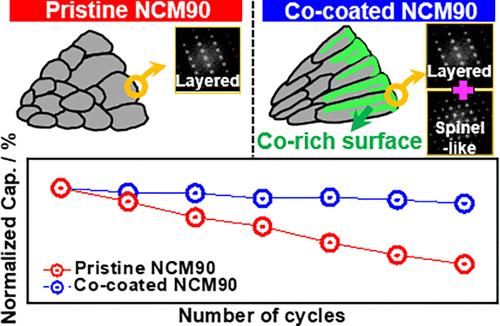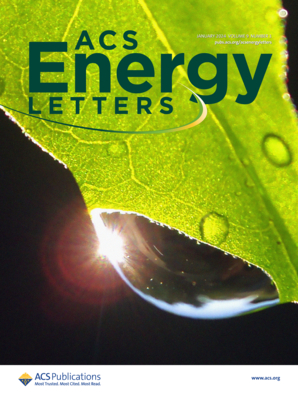在富镍阴极材料中引入 Co 纳米壳,制造高倍率长寿命锂离子电池
IF 19.3
1区 材料科学
Q1 CHEMISTRY, PHYSICAL
引用次数: 0
摘要
传统上,钴(Co)是 LiMO2(M = Ni、Co、Mn、Al)阴极材料中的基本元素。为了解决这个问题,最近的研究集中于最大限度地发挥有限钴量的作用。在此,我们介绍了一种充分利用钴的新方法,即通过单一共沉淀过程在富镍[Ni0.90Co0.05Mn0.05](OH)2 前驱体上形成钴纳米壳。在煅烧过程中,Co 纳米壳起到了烧结抑制剂的作用,从而产生了在基准 Li[Ni0.90Co0.05Mn0.05]O2 阴极材料中观察不到的柱状结构。此外,引入 Co 纳米壳有助于形成尖晶石状结构,从而在电化学循环过程中促进 Li+(脱)插层。这项研究不仅提供了一种充分利用有限 Co 量的新方法,还为合成高性能阴极材料提供了一种简便、经济的方法。本文章由计算机程序翻译,如有差异,请以英文原文为准。

Introducing Co Nanoshells onto Ni-Rich Cathode Materials for High-Rate Long-Life Li-Ion Batteries
Conventionally, cobalt (Co) is an essential element in LiMO2 (M = Ni, Co, Mn, Al) cathode materials. However, its high cost and price fluctuations hinder its full utilization, limiting the average fraction of Co. To address this problem, recent studies focused on maximizing the effects of a limited amount of Co. Herein, we introduce a new approach that fully utilizes Co by forming a Co nanoshell on a Ni-rich [Ni0.90Co0.05Mn0.05](OH)2 precursor via a single coprecipitation process. The Co nanoshell acts as a sintering inhibitor during calcination, thereby generating columnar structures that are not observed in the baseline Li[Ni0.90Co0.05Mn0.05]O2 cathode material. In addition, introducing the Co nanoshell contributes to forming spinel-like structures that facilitate Li+ (de)intercalation during electrochemical cycling. This study not only provides a new approach that fully utilizes a limited amount of Co but also offers a facile and cost-effective method in synthesizing high-performance cathode materials.
求助全文
通过发布文献求助,成功后即可免费获取论文全文。
去求助
来源期刊

ACS Energy Letters
Energy-Renewable Energy, Sustainability and the Environment
CiteScore
31.20
自引率
5.00%
发文量
469
审稿时长
1 months
期刊介绍:
ACS Energy Letters is a monthly journal that publishes papers reporting new scientific advances in energy research. The journal focuses on topics that are of interest to scientists working in the fundamental and applied sciences. Rapid publication is a central criterion for acceptance, and the journal is known for its quick publication times, with an average of 4-6 weeks from submission to web publication in As Soon As Publishable format.
ACS Energy Letters is ranked as the number one journal in the Web of Science Electrochemistry category. It also ranks within the top 10 journals for Physical Chemistry, Energy & Fuels, and Nanoscience & Nanotechnology.
The journal offers several types of articles, including Letters, Energy Express, Perspectives, Reviews, Editorials, Viewpoints and Energy Focus. Additionally, authors have the option to submit videos that summarize or support the information presented in a Perspective or Review article, which can be highlighted on the journal's website. ACS Energy Letters is abstracted and indexed in Chemical Abstracts Service/SciFinder, EBSCO-summon, PubMed, Web of Science, Scopus and Portico.
 求助内容:
求助内容: 应助结果提醒方式:
应助结果提醒方式:


